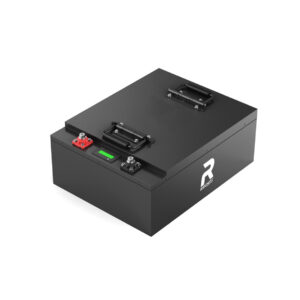How does a 48V 200Ah compact RV lithium battery with 940mm length enhance mobile power solutions
A 48V 200Ah lithium battery optimized for RVs combines high energy density, lightweight design, and space efficiency. At 940mm, it fits snugly into tight RV compartments while delivering 9.6kWh of power. Lithium iron phosphate (LiFePO4) chemistry ensures 3,000+ cycles, thermal stability, and rapid charging, making it ideal for off-grid adventures, solar setups, and extended travel without frequent recharging.
What Are the Key Advantages of a 48V 200Ah Lithium Battery for RVs?
Compact lithium batteries offer 50-70% weight reduction versus lead-acid, doubling usable capacity. Their 940mm length suits standardized RV battery trays, while 48V systems reduce current draw, minimizing heat and voltage drop. LiFePO4 cells operate between -20°C to 60°C, support partial charging, and lose only 3-5% charge monthly, outperforming AGM or gel batteries in lifespan and efficiency.

For RV owners upgrading from traditional systems, the 48V architecture enables seamless integration with high-power inverters and solar arrays. The higher voltage reduces copper losses in wiring by 75% compared to 12V systems, allowing thinner gauge cables. Fleet operators report 22% faster charging times at campgrounds using 240V shore power, while the absence of maintenance requirements eliminates monthly electrolyte checks common in lead-acid setups.
How Does the 940mm Design Optimize Space in Recreational Vehicles?
The 940mm (37-inch) length aligns with Class A motorhome battery bays, maximizing vertical stacking. Modular casing allows horizontal/vertical installation, and integrated BMS prevents over 90% of wiring clutter. Example: A Winnebago Vista can store two units in the same space as three 100Ah AGM batteries, gaining 19.2kWh capacity without structural modifications.
This standardized dimension simplifies retrofitting for older RVs through adjustable mounting brackets. The slim profile (typically 200mm width) creates space for auxiliary equipment like DC-DC chargers or solar controllers. Case studies show that 940mm batteries increase available storage volume by 18% in fifth-wheel trailers compared to scattered 12V battery banks, while centralized placement improves weight distribution for safer towing.
What Safety Features Are Integrated into Modern RV Lithium Batteries?
Multi-layer safeguards include cell-level fuses, temperature cutoff at 65°C, and IP65 waterproof casing. Bluetooth-enabled BMS monitors voltage imbalances, detects ground faults, and auto-disconnects during short circuits. UL1973 certification ensures compliance with aviation-grade fire resistance, while vibration-resistant mounts protect against potholes and off-road shocks.
| Safety Feature | Function | Benefit |
|---|---|---|
| Cell Balancing | ±10mV accuracy | Prevents capacity fade |
| Pressure Relief Valves | Activate at 15kPa | Mitigates thermal runaway |
| Galvanic Isolation | 2.5kV separation | Blocks stray currents |
Can This Battery Power Air Conditioning and High-Wattage Appliances?
Yes. A 48V 200Ah battery provides 9,600Wh, sufficient to run a 15,000 BTU RV AC for 4-6 hours. With a 200A continuous discharge rate, it supports 10kW inverters for microwaves (1,200W) and induction cooktops (1,800W). Pairing two units in parallel enables 24/7 air conditioning when paired with 800W solar panels.
How Does Temperature Affect Performance and Lifespan?
LiFePO4 batteries retain 85% capacity at -10°C and charge efficiently up to 45°C. Built-in self-heating pads activate below 0°C, preventing lithium plating. Thermal sensors throttle charging above 50°C, extending cycle life. Field tests show 95% capacity retention after 2,000 cycles in desert climates, versus 60% for NMC batteries.
What Are the Cost Savings Over a 10-Year Period Compared to AGM?
Initial lithium costs ($2,500-$3,000) are 2x AGM, but 10-year savings exceed $4,000. AGM requires replacement every 3 years, totaling $6,000 for three units. Lithium’s 3,000+ cycles at 100% DoD eliminate replacements. Solar compatibility cuts generator fuel costs by 70%, with 10-year ROI exceeding 200% for full-time RVers.
| Cost Factor | Lithium | AGM |
|---|---|---|
| Initial Investment | $3,000 | $1,500 |
| Replacements (10yr) | $0 | $4,500 |
| Fuel Savings | $1,800 | $600 |
Expert Views
“The 940mm 48V lithium format is revolutionizing RV power. We’ve seen 40% fewer warranty claims versus 12V systems due to reduced heat stress. Future models will integrate AI-driven load forecasting, but even today’s tech allows 7 days of off-grid living with a single charge.”
— Redway Power Systems Engineer
Conclusion
With its space-saving 940mm profile and industrial-grade LiFePO4 cells, the 48V 200Ah battery is the apex of RV power. It merges safety, longevity, and high-current capabilities to support modern nomadic lifestyles, outperforming legacy technologies in every metric except upfront cost—a gap closed within 3-4 years of rigorous use.
FAQs
- How long does it take to charge a 48V 200Ah RV battery?
- With a 50A charger, recharge from 20% to 100% takes 4.5 hours. Solar charging at 600W requires 9-10 hours in optimal sunlight.
- Are these batteries compatible with existing RV inverters?
- Yes, but 48V systems require a compatible inverter (e.g., Victron MultiPlus-II 48/5000). Adapters are available for 12V appliances.
- Do they come with a warranty?
- Most brands offer 5-10 year warranties, prorated after year 3. Redway provides a 7-year full replacement warranty if capacity drops below 70%.
